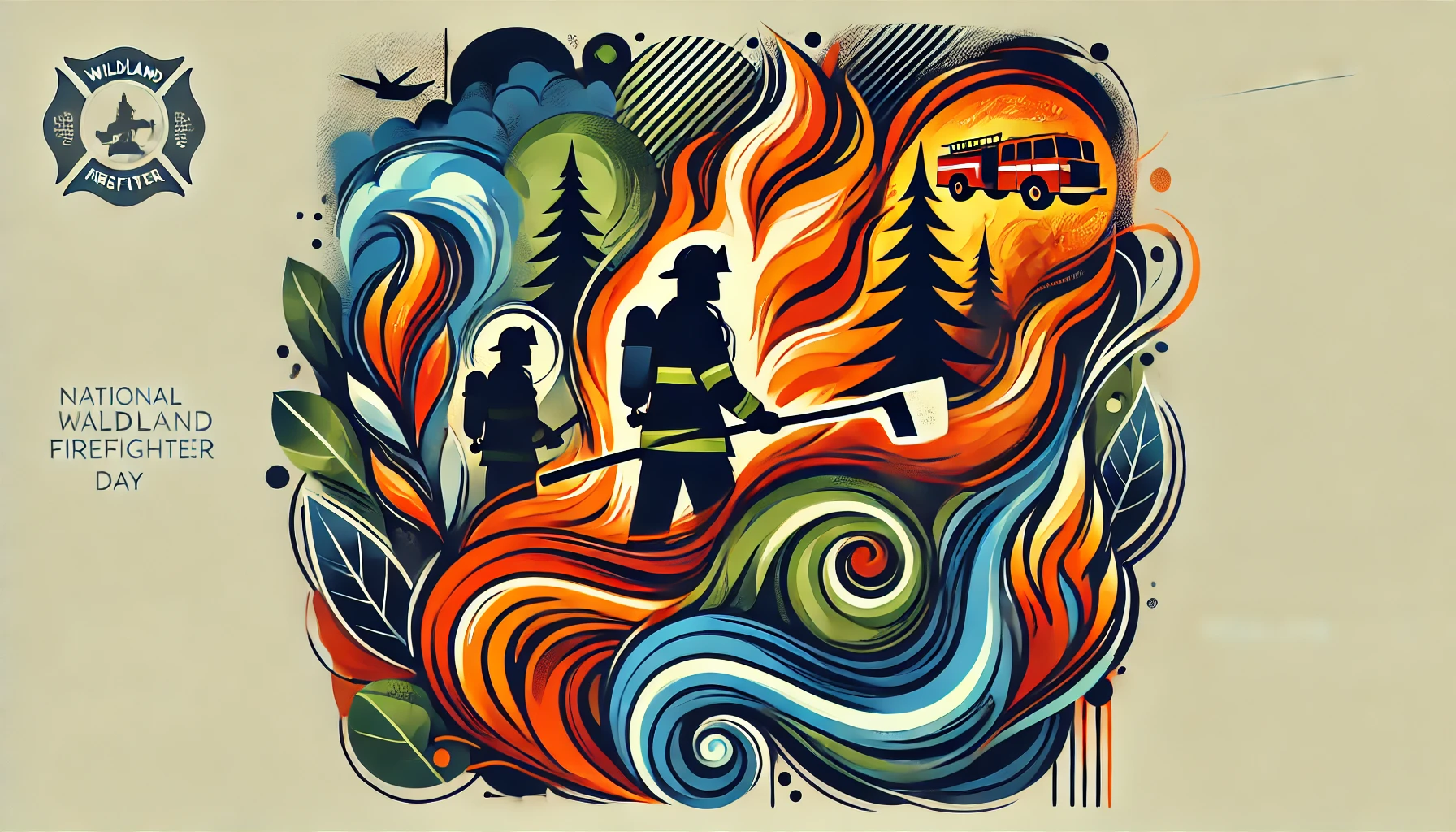
- This event has passed.
National Wildland Firefighter Day
July 2

National Wildland Firefighter Day is a poignant reminder of the bravery and dedication of those who confront one of nature’s most formidable elements. Established to honor the men and women who battle wildfires across the country, this day serves as an annual observance to recognize their courage and sacrifice. It is typically celebrated on July 7th, marking a day of tribute to the heroes who protect our forests and communities from the ravages of wildfire.
This special day was initiated to not only acknowledge the hard work and risks taken by these firefighters but also to increase public awareness about the dangers of wildfires and the importance of fire prevention. It’s a day for communities to come together, express gratitude, and learn more about the critical role wildland firefighters play in preserving our natural landscapes.
The Role and Challenges of Wildland Firefighters
Wildland firefighters are tasked with a formidable job: controlling and extinguishing fires in natural settings like forests, grasslands, and other undeveloped areas. Unlike structural firefighters, wildland firefighters use different techniques and equipment to manage their unique challenges. They often create controlled burns to eliminate fuel for potentially larger fires and use tools such as chainsaws, fire retardants, and shovels to construct firebreaks.
The challenges faced by these individuals are immense. They work in extreme conditions, facing intense heat, smoke, and unpredictable fire behavior while carrying heavy gear over rugged terrain. The physical demands are matched by the mental strain of long shifts, often in remote locations away from family and friends. Moreover, the increasing frequency and intensity of wildfires due to climate change have only heightened the risks and challenges these firefighters face daily.
Historical Impact of Wildland Fires
Wildland fires have shaped much of the history and landscape of various regions around the world. In the United States, fires like the Great Fire of 1910, which burned through Idaho, Montana, and Washington, are historical landmarks that prompted significant changes in fire management policies and practices. This particular fire burned over three million acres and led to the establishment of the U.S. Forest Service’s fire suppression policies.
These fires not only cause immediate damage but also have long-term ecological impacts. They can alter ecosystems, threaten endangered species, and disrupt community lives and economies. However, fires are also a natural part of many ecosystems, helping to clear dead material, fertilize the soil, and encourage new growth. Understanding the historical impact of these fires is crucial for developing effective management strategies that balance both ecological health and public safety.
Advancements in Wildland Firefighting
Over the years, the field of wildland firefighting has seen significant technological and methodological advancements. Today, firefighters have access to advanced tools like satellite imagery and drones to monitor fire spread and behavior from a safe distance. Geographic Information Systems (GIS) technology is also used extensively to map fire progression and plan effective responses.
Training methods have also evolved, with simulations and virtual reality environments preparing firefighters for the unpredictable nature of wildfires. This training not only enhances safety but also improves the efficiency and effectiveness of firefighting efforts. Additionally, new firefighting chemicals that are less harmful to the environment are being developed to replace traditional fire retardants.
How to Support and Honor Wildland Firefighters
Supporting and honoring wildland firefighters can take many forms. Community members can participate in or organize events on National Wildland Firefighter Day that raise awareness and funds for firefighting resources and injured firefighters. Educational programs can also be conducted to teach the public about fire prevention and safety, reducing the overall fire risk.
Another way to show support is by following local fire regulations, such as burn bans and fireworks restrictions, especially during peak fire seasons. Advocating for better policies and support for firefighters through communication with local representatives can also make a significant difference. Finally, simple acts of gratitude, like thank-you cards or banners in community centers, can go a long way in boosting the morale of these courageous individuals.
Author’s Opinion:
The valor and sacrifice of wildland firefighters cannot be overstated. As climate change escalates the frequency and intensity of wildfires, the need for robust support and recognition of these brave men and women is more critical than ever. National Wildland Firefighter Day not only highlights their heroism but also reminds us of our collective responsibility in wildfire prevention and environmental stewardship.
10 Wishes for National Wildland Firefighter Day
- May your courage continue to inspire and your efforts keep our lands safe.
- Wishing you strength and safety as you protect our natural heritage.
- On National Wildland Firefighter Day, we honor your dedication and sacrifice.
- May each day bring renewed strength and safety to all wildland firefighters.
- Wishing for favorable conditions and safety for all those who battle wildfires.
- May your bravery be matched with the respect and support you deserve.
- Wishing you success in every firefight and quick returns to safety thereafter.
- May this day bring awareness and gratitude towards your heroic deeds.
- Wishing you and your teams strength and perseverance through the fire season.
- Here’s to hoping today reminds everyone of the vital role you play in keeping us safe.
10 Unusual Facts about Wildland Firefighting
- Some wildland firefighters use controlled burns to fight fire with fire.
- Firefighters can use tools like chainsaws to create firebreaks that stop the spread of wildfires.
- The smokejumpers are specially trained firefighters who parachute into remote areas to combat fires.
- Wildland firefighting gear can weigh up to 45 pounds.
- The first recorded use of controlled burning by firefighters was by Indigenous peoples.
- Wildfires can create their own weather systems, making them unpredictable and dangerous.
- Fire retardants used can cover up to 100 feet wide per drop from firefighting aircraft.
- The longest burning wildfire lasted for over 6 months in Australia.
- Firefighting teams often include specially trained dogs to search for survivors in the aftermath of fires.
- Some wildland firefighters are seasonal, working primarily during peak fire seasons.




